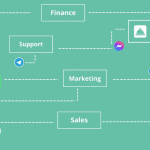Direct messaging applications like WhatsApp and Messenger are becoming the new customer service paradigm: let’s figure out why.
If we think about on the way in which we interact with the outside world every day through our smartphone, we realize how it’s getting more and more difficult to await: we expect an immediate response to any of our requests and if this doesn’t occur, our attention it easily shifts to the next matter.
This happens both in our interpersonal relationships and in the interactions we establish with the companies from which we would like to make a purchase or have purchased a product or service.
“For the first time in history, mobile traffic surpassed desktop traffic in 2018”
Moreover, with the mobile getting the better, (which currently accounts for more than 50% of total web traffic), it becomes more and more difficult to keep a user on a website for more than a few minutes, especially if a human assistance during its navigation is required.
For this reason, the traditional chat tools we see installed on every website are becoming extremely obsolete and increasingly less suitable to meet a clientele that is increasingly demanding and less patient.

In order to keep up with this evolution, more and more companies are moving their customer service to users’ pre-installed applications, so that they can keep the interaction active once the visitor has left the website.
This strategy features several advantages: it avoids, for example, losing conversations halfway, allows to reach open rates close to 100% to the answers of our customer service, as well as to immediately collect information on the user who is contacting our company.

A specific feature of this type of application is its flexibility: the use of tools such as WhatsApp or Facebook Messenger remove the instanteneity expectation by the user who becomes aware of being able to manage his or her request for assistance in the same way in which he or she manages a conversation with a friend.
The conversation continues on a channel the user feels comfortable in using, and where the conversation is automatically saved; the assistance turns into a friendly and equal relationship, leading to the maximization of the only metric that really counts: the satisfaction of our client.
With more than 50 billion messages sent every day via WhatsApp and Messenger, we must be aware that these apps are the “place” where our customers spend a large chunk of their time. If we want to build a personal relationship with them as a brand or company, we need to meet them there.
So, it’s time to think about how not to lose this opportunity.

About the author: Hello! I am Carlo and I am one of the co-founder at Callbell, the first communication platform designed to help sales and support teams to collaborate and communicate with customers through direct messaging applications such as WhatsApp, Messenger, Telegram and (soon) Instagram Direct




